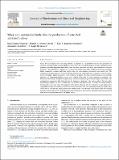Por favor, use este identificador para citar o enlazar a este item:
http://hdl.handle.net/10261/303274COMPARTIR / EXPORTAR:
 SHARE SHARE
 CORE
BASE CORE
BASE
|
|
| Visualizar otros formatos: MARC | Dublin Core | RDF | ORE | MODS | METS | DIDL | DATACITE | |

| Título: | Whey as a sustainable binder for the production of extruded activated carbon |
Autor: | Llamas-Unzueta, Raúl CSIC ORCID; Montes Morán, Miguel Ángel CSIC ORCID ; Ramírez Montoya, Luis Adrián CSIC ORCID ; Concheso Álvarez, Alejandro CSIC ORCID ; Menéndez Díaz, José Ángel CSIC ORCID | Palabras clave: | Whey Activated carbon extrudates Extruded carbon Maillard binder Activated carbon binder H2S removal |
Fecha de publicación: | 1-jun-2022 | Editor: | Elsevier | Citación: | Journal of Environmental Chemical Engineering 10(3): 107590 (2022) | Resumen: | Whey, the main by-product of the dairy industry, is proposed as a sustainable binder for the production of extruded activated carbon. Coconut shell char was mixed with controlled quantities of either rehydrated whey powders or partially dehydrated liquid whey. After extrusion, extrudates were dried, and carbonised or activated under N2 or CO2 atmosphere, respectively. A comprehensive study of the effect of different parameters including binder proportion, coconut shell char particle size and carbonisation temperature was carried out. The composition of whey prompted Maillard reactions boosted with temperature that conferred a resin-like behaviour to the binder. Quality parameters of the resulting extrudates were their ball-mill hardness, real and bulk densities. All whey-bound pellets retained their original shape after the high temperature treatment. The hardness of those whey extrudates was particularly remarkable considering the biomass origin of this binder. The carbonisation temperature had little effect in the hardness or densities of the carbon pellets. The best pellet formulation comprised the use of coconut shell char powders with particle sizes < 212 µm, in mixtures having a 7/3 char/dry whey mass ratio. The properties of the pellets obtained after the activation of such pellets were comparable to those of commercial activated carbon extrudates. The use of partially dehydrated liquid whey rather than re-hydrated dry whey rendered very similar results. The alkalinity of the binder made the resulting activated carbons adequate for H2S removal at room temperature. An economic estimation of the process placed whey in a practical position within the binder market. | Versión del editor: | https://doi.org/10.1016/j.jece.2022.107590 | URI: | http://hdl.handle.net/10261/303274 | DOI: | 10.1016/j.jece.2022.107590 | ISSN: | 2213-2929 |
| Aparece en las colecciones: | (INCAR) Artículos |
Ficheros en este ítem:
| Fichero | Descripción | Tamaño | Formato | |
|---|---|---|---|---|
| Whey_sustainable_binder_Llamas.pdf | 5,39 MB | Adobe PDF |  Visualizar/Abrir |
CORE Recommender
SCOPUSTM
Citations
5
checked on 28-abr-2024
WEB OF SCIENCETM
Citations
3
checked on 26-feb-2024
Page view(s)
19
checked on 29-abr-2024
Download(s)
131
checked on 29-abr-2024
Google ScholarTM
Check
Altmetric
Altmetric
Este item está licenciado bajo una Licencia Creative Commons

